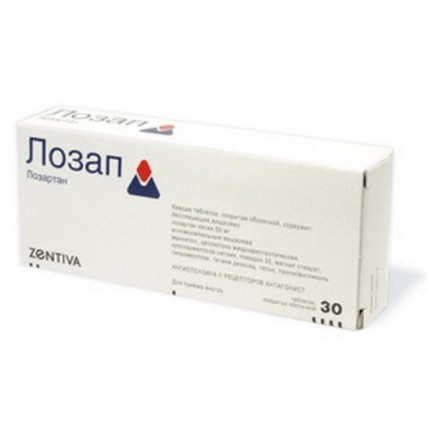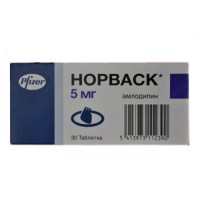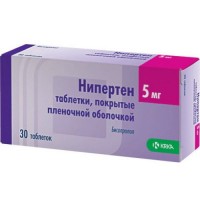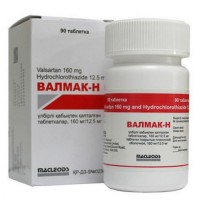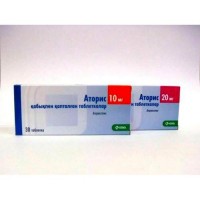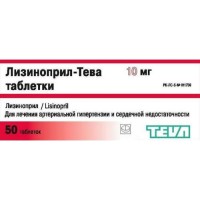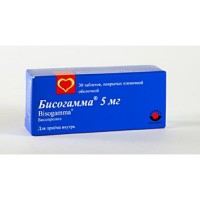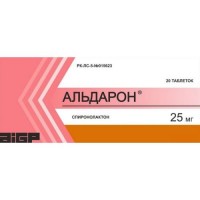Losap 30s 50 mg coated tablets
- $21.20
The instruction for medical use of LOZAP medicine the Trade name Lozap Mezhdunarodnoye the unlicensed name Lozartan Lekarstvennaya the Tablet form, film coated 50 mg Structure One tablet contains active agent - lozartan potassium of 50 mg, excipients: Mannitolum – 50.00 mg, cellulose microcrystalline – 80.00 mg, krospovidon – 10.00 mg, silicon dioxide colloidal anhydrous – 2.00 mg, talc – 4.00 mg, magnesium stearate – 4.00 mg, structure of a cover Sepifilm 752 white: a hydroksipropilmetiltsellyuloza, cellulose microcrystalline, a macrogoal stearate 2000, the titan dioxide (E171), a macrogoal 6000 Description of the Tablet of an oval form, biconvex, divisible in half, film coated white or almost white color, about 11.0 x 5.5 mm in size Pharmacotherapeutic group the Drugs influencing a system renin-angiotensin. Angiotensin II antagonists. Lozartan the ATX C09CA01 Code the Pharmacological Pharmacokinetics Absorption Later properties of intake, lozartan is well absorbed from the digestive tract (DT) and is exposed to presistemny metabolism with formation of a carboxyl metabolite and other inactive metabolites. System biological availability of a lozartan in the form of tablets makes about 33%. Average maximum concentration of a lozartan and its active metabolite are reached in 1 hour and 3 - 4 hours, respectively. Distribution Lozartan and his active metabolite on ³ 99% contact proteins of blood plasma, first of all albumine. The volume of distribution of a lozartan is 34 liters. Biotransformation About 14% of a lozartan at oral administration turns into an active metabolite. Except an active metabolite, inactive metabolites are also formed. Removal Plasma clearance of a lozartan and its active metabolite makes 600 ml/minute and 50 ml/minute, respectively. The renal clearance of a lozartan and its active metabolite is about 74 ml/minute and 26 ml/minute, respectively. At oral administration of a lozartan about 4% of a dose it is allocated in not changed view with urine, and about 6% of a dose are allocated with urine in the form of an active metabolite. Pharmacokinetics of a lozartan and its active metabolite linear at oral administration of a lozartan of potassium in doses up to 200 mg. After oral administration of concentration of a lozartan and its active metabolite about 2 hours and 6 – 9 hours, respectively decrease poliexponentsialno with final elimination half-life. At use once a day in a dose of 100 mg the significant accumulation in blood plasma of a lozartan and its active metabolite is not observed. Lozartan and his active metabolite are brought with bile and urine. After oral administration about 35% and 43% 58% and 50% with a stake, respectively are removed with urine, and. Pharmacokinetics at separate groups of patients: Concentration of a lozartan and its active metabolite in blood plasma at patients of advanced age with arterial hypertension significantly do not differ from concentration at young patients with arterial hypertension. Concentration of a lozartan in blood plasma are twice higher at women with arterial hypertension, than at men. Concentration of an active metabolite at men and women did not differ. Patients with alcoholic cirrhosis of light and moderate severity have concentration of a lozartan and its active metabolite in blood plasma were respectively in 5 and 1.7 times is higher, than at healthy volunteers. Concentration of a lozartan in blood plasma did not change at patients with clearance of creatinine higher than 10 ml/minute. The area indicator under a curve concentration time (AUC) is twice higher at patients to whom carry out a hemodialysis, in comparison with patients with normal function of kidneys. Plasma concentration of an active metabolite do not change at patients with renal failures or patients to whom carry out a hemodialysis. Lozartan and his active metabolite are not brought from an organism when carrying out a hemodialysis. Pharmacodynamics the action Mechanism Lozartan is a synthetic antagonist of receptors of angiotensin ІІ (AT1 type) for oral administration. Angiotensin II – a powerful vasoconstrictor – is active hormone renin-angiotenzinovoy of a system and one of the most important factors of a pathophysiology of arterial hypertension. Angiotensin II contacts receptors of AT1 which are in smooth muscles of vessels, in adrenal glands, in kidneys and in heart), defining a number of important biological effects, including vasoconstriction and release of Aldosteronum. Angiotensin II also stimulates proliferation of smooth muscle cells. Lozartan selectively blocks AT1 receptors. Lozartan and him pharmacological an active metabolite - carboxyl acid (E-3174) in vitro and in vivo block all physiologically significant effects of angiotensin II, irrespective of a source of origin and a way of synthesis. Lozartan has no agonistic effect and does not block other receptors of hormones or ion channels which take part in regulation of a cardiovascular system. Moreover, lozartan does not suppress APF (kininaza of II) – enzyme which promotes bradykinin disintegration. Thereof the potentsiation for emergence of the side effects mediated by bradykinin is not observed. During use of a lozartan the elimination of negative back reaction of angiotensin ІІ on secretion of renin leads to increase in activity of renin in blood plasma (ARP). Such increase in activity leads to increase in level of angiotensin ІІ in blood plasma. Despite such increase, antihypertensive activity and reduction of concentration of Aldosteronum in blood plasma remain that demonstrates effective blockade of receptors of angiotensin ІІ. After phase-out of a lozartan activity of renin in blood plasma and angiotensin levels ІІ within 3 days return to initial indicators. As lozartan, and its main metabolite, have higher affinity to AT1retseptoram, than to AT2. The active metabolite is 10 - 40 times more active, than lozartan (at recalculation on weight). Lozap reduces the general peripheric vascular resistance (GPVR), concentration in blood of adrenaline and Aldosteronum, arterial blood pressure, pressure in a small circle of blood circulation, reduces an afterload, renders diuretic effect. Lozap interferes with development of a hypertrophy of a myocardium, increases tolerance to physical activity at patients with heart failure. After single dose of Lozap antihypertensive action (decrease in systolic and diastolic arterial blood pressure) reaches a maximum in 6 h, then during 24 h gradually decreases. The maximum antihypertensive effect is reached in 3-6 weeks after the beginning of reception of Lozap. Pharmacological data indicate that concentration of a lozartan in blood plasma at patients with cirrhosis considerably increases. Indications - treatment of essential hypertensia at adults - treatment of a disease of kidneys at adult patients with arterial hypertension and diabetes of the II type with a proteinuria of ≥0.5 g/days as a part of antihypertensive therapy - prevention of development of cardiovascular complications, including a stroke at patients with the arterial hypertension and a hypertrophy of a left ventricle confirmed to the ECG with a research - chronic heart failure (as a part of combination therapy, at intolerance or inefficiency of therapy by APF inhibitors) the Route of administration and doses Lozap accept inside, regardless of meal, frequency rate of reception - 1 time a day. In essential arterial hypertension the average daily dose makes 50 mg once a day. The maximum antihypertensive effect is reached in 3 – 6 weeks after an initiation of treatment. At some patients the increase in a dose of drug to 100 mg a day (morning) can be more effective. Lozap can be appointed with other antihypertensive drugs, especially with diuretics (for example, a hydrochlorothiazide). Patients with hypertensia and diabetes ІІ type (proteinuria of ≥0.5 g/days) the Usual initial dose makes 50 mg once a day. The dose can be raised to 100 mg once a day, depending on indicators of arterial blood pressure in one month after an initiation of treatment. Lozap it is possible to apply with other antihypertensive drugs (for example, diuretics, blockers of calcium channels, blockers alpha or beta receptors, drugs of the central action) and also with insulin and other widely used hypoglycemic drugs (for example, sulphonylurea, glitazona and inhibitors of glucosidase). Heart failure the Initial dose of a lozartan makes 12.5 mg once a day. As a rule, the dose is titrated with a week interval (i.e. 12.5 mg once a day. 25 mg once a day. 50 mg once a day, 100 mg once a day) to a usual maintenance dose of 50 mg once a day depending on shipping of the patient. Reduction of risk of development of a stroke in patients with the arterial hypertension and a hypertrophy of a left ventricle confirmed to the ECG the Usual initial dose makes 50 mg Lozap once a day. Depending on decrease in level of arterial blood pressure, it is necessary to add Hydrochlorthiazidum in a low dose to treatment and/or to increase Lozap's dose to 100 mg once a day. Separate groups of patients Use for patients with a reduced volume of the circulating blood At patients with a reduced volume of the circulating blood (for example, at intake of diuretics in high doses) an initial dose of drug it is necessary to lower to 25 mg once a day (see the section Special instructions). Use for patients with renal failures and patients to whom carry out a hemodialysis have no need for correction of an initial dose for patients with renal failures and also for patients to whom carry out a hemodialysis. Use for patients with an abnormal liver function For patients with abnormal liver functions in the anamnesis it is necessary to consider a question of prescribing of drug in lower dose. There is no experience of treatment of patients with heavy abnormal liver functions therefore Lozap is contraindicated to this group of patients (see the sections Contraindication and Special Instructions). Use for patients of advanced age In spite of the fact that treatment of patients is more senior than 75 years it is necessary to begin with care, with 25 mg, as a rule, there is no need for correction of an initial dose. Side effects Side effects are provided with the following frequency: Often: ≥1/100 - & lt, 1/10, Infrequently: ≥1/1000 - & lt, 1/100, is rare: ≥1/10000 - & lt, 1/1000, Is very rare: & lt, 1/10000, is not known: frequency cannot be estimated on the basis of available data. Often - dizziness, an asthenia, weakness - hypotension, including orthostatic - a hypoglycemia, a hyperpotassemia - anemia - a renal failure, a renal failure - increase in level of urea of blood, creatinine in blood serum and potassium in blood serum Infrequently - drowsiness, headaches, sleep disorders - the cardiopalmus, trembling, short wind, stenocardia - symptomatic hypotension, dose-dependent orthostatic effect - abdominal pain, constipations, diarrhea, dyspepsia, nausea, vomiting - an asthenia, weakness, hypostases, puffiness, thorax pain - a dorsodynia, muscular spasms - cough, congestion of a nose, pharyngitis, a disease of bosoms, upper respiratory tract infections - urticaria, an itching, rash - dispnoe is rare - reactions of hypersensitivity, anaphylactic reactions, a Quincke's disease, including the laryngeal edema and drinks leading to obstruction of airways and/or edema of face, lips, drinks and/or language. Some of these patients in the anamnesis had instructions on a Quincke's disease at intake of APF inhibitors - paresthesias - faints, fibrillation of auricles, cerebrovascular disturbances, a stroke - hepatitis - increase in ALT - a vasculitis, including Shenleyn-Genokh Neizvestno's purpura - anemia, thrombocytopenia - a ring in ears - grippopodobny symptoms, cough - orthostatic hypotension, migraine - urinary tract infections - an indisposition - an abnormal liver function - photosensitivity, an erythrosis - myalgia, an arthralgia, a rhabdomyolysis - erectile dysfunction, impotence - a depression - a hyponatremia In most cases Lozap is well had, side effects have passing character and do not demand drug withdrawal. Contraindications - hypersensitivity to active agent or to drug excipients - a liver failure of heavy degree - pregnancy and the period of a lactation - children's and teenage age up to 18 years - combined use with aliskireny at patients with diabetes Medicinal interactions Other hypotensive drugs can enhance hypotensive effect of Lozap. Simultaneous use with other drugs which can induce developing of arterial hypotension as side reaction (tricyclic antidepressants, antipsychotic means, Baclofenum and amifostin) can increase risk of developing of hypotension. Lozartan is metabolized, mainly, with the participation of the system of P450 cytochrome (CYP) 2C9 to an active carboxyacid metabolite. In clinical trial it was established what flukonazol (CYP2C9 inhibitor) reduces exposure of an active metabolite approximately by 50%. It is established that simultaneous treatment lozartany and rifampicin (inductor of enzymes of metabolism) leads to decrease by 40% of concentration of an active metabolite in blood plasma. The clinical value of this effect is unknown. There are no differences in exposure at simultaneous use of Lozap with fluvastatiny (weak CYP2C9 inhibitor). As well as at use of other drugs which block angiotensin II or its effects, the accompanying use of drugs which detain potassium in an organism (for example, kaliysokhranyayushchy diuretics: Spironolactonum, Triamterenum, amiloride), or can increase potassium levels (for example, heparin) and also kaliysoderzhashchy additives or substitutes of salt, can lead to increase in content of potassium in blood serum. Simultaneous use of such means is not recommended. About reversible increase in concentration of lithium in blood serum and also about its toxicity it was reported at simultaneous use of lithium with APF inhibitors. It was also very seldom reported about cases at use of antagonists of receptors of angiotensin ІІ. Simultaneous treatment by lithium and lozartany should be carried out with care. If use of such combination is considered necessary, it is recommended to check lithium levels in blood serum throughout simultaneous use. At simultaneous use of antagonists of angiotensin ІІ and non-steroidal anti-inflammatory drugs (for example, selection inhibitors of cyclooxygenase-2 (TsOG-2), acetylsalicylic acid in the doses having anti-inflammatory effect, non-selective NPVP), the antihypertensive effect can be weakened. Simultaneous use of antagonists of angiotensin ІІ or diuretics with NPVP can lead to increase in risk of deterioration in function of kidneys, including possible development of an acute renal failure and also to increase in level of potassium in blood serum, especially at patients with the existing renal failures. It is necessary to appoint such combination with care, especially to patients of advanced age. Patients should carry out the corresponding hydration and also it is necessary to consider a question concerning monitoring of function of kidneys after the beginning of the accompanying therapy, and further – periodically. Double blockade system renin-angiotensin-aldosteronovoy Double blockade by blockers of receptors of angiotensin, APF inhibitors or aliskireny results system renin-angiotensin-aldosteronovoy in risk of hypotonia, a hyperpotassemia and also to renal failures (including to an acute renal failure), in comparison with monotherapy. Careful control of the ABP, function of kidneys, and level of electrolytes at the patients accepting Lozap and other drugs which influence renin-angiotensin-aldosteronovuyu a system is necessary. Combined use of an aliskiren and Lozap is contraindicated to patients with diabetes. It is not necessary to appoint in common aliskiren with Lozap to patients with a renal failure (SKF & lt, 60 ml/min.). Special instructions Hypersensitivity Quincke's Disease. It is necessary to control often a condition of patients with a Quincke's disease in the anamnesis (edema of face, lips, throats and/or language). Arterial hypotension and a water and electrolytic imbalance Simptomat
chesky arterial hypotension, especially after use of the first dose of drug or after increase in a dose, can arise at patients with a reduced intravascular volume and/or deficiency of sodium, caused by use of strong diuretics, dietary restriction of consumption of salt, diarrhea or vomiting. Before an initiation of treatment Lozap it is necessary to carry out correction of such states or to use drug in lower initial dose. The electrolytic imbalance the Electrolytic imbalance is often observed at patients with renal failures (with or without diabetes) that it is necessary to take into account. At patients with diabetes of the II type and a nephropathy, the frequency of emergence of a hyperpotassemia was higher in groups of use of Lozap, than in group of use of placebo. Therefore it is necessary to check often potassium concentration in blood plasma and indicators of clearance of creatinine, especially at patients with heart failure and clearance of creatinine of 30 - 50 ml/minute. Simultaneous use of the drug Lozap and the kaliysokhranyayushchy diuretics, additives of potassium and substitutes of salt containing potassium is not recommended. An abnormal liver function In view of the data on pharmacokinetics indicating significant increase in concentration of Lozap in blood plasma at patients with cirrhosis it is necessary to consider a question of a drug dose decline for patients abnormal liver functions in the anamnesis. The drug Lozap should not be used at patients with heavy abnormal liver functions in view of lack of experience of use. The renal failure Was reported about changes of function of kidneys, including a renal failure, connected with oppression system renin-angiotenzinovoy (especially patients with dependence have functions of kidneys from a system renin-angiotensin-Aldosteronum, that is patients with heavy dysfunctions of heart or with already existing renal failures). As well as at use of other drugs influencing a system renin-angiotensin-Aldosteronum it was reported about increase in levels of urea of blood and creatinine of blood serum at patients with a bilateral stenosis of renal arteries or with a stenosis of an artery of the only kidney. These changes of function of kidneys can be reversible after the therapy termination. It is necessary to apply with care Lozap at patients with a bilateral stenosis of renal arteries or with a stenosis of an artery of the only kidney. Simultaneous use of Lozap and APF inhibitors worsens function of kidneys therefore such combination is not recommended. Transplantation of a kidney Is not present experience of use of drug for patients which carried out transplantation of a kidney recently. Primary hyper aldosteronism At patients with primary aldosteronism, in most cases, is absent the answer to the hypotensive medicines operating by means of inhibition system renin-angiotenzinovoy. Therefore, use of a lozartan is not recommended. Coronary heart disease and cerebrovascular diseases As well as in case of use of other antihypertensive drugs, can lead an excessive lowering of arterial pressure at patients with coronary heart disease and cerebrovascular diseases to development of a myocardial infarction or stroke. Heart failure As well as at use of other drugs which influence renin-angiotenzinovuyu a system for patients with heart failure with/without renal failure exists risk of developing heavy arterial hypotension and (often acute) renal failure. There is no sufficient therapeutic experience of use of Lozap for patients with heart failure and the accompanying heavy renal failure, at patients with heavy heart failure (the class ІV on NYHA) and also at patients with heart failure and symptomatic, life-threatening arrhythmia of heart. Therefore Lozap it is necessary to apply with care in this group of patients. It is necessary to apply at the same time with care Lozap and beta-blockers. Stenosis of aortal and mitral valves, subaortic hypertrophic stenosis. As well as at use of other vazodilatator, with special care appoint drug to patients with a stenosis of aortal and mitral valves or a subaortic hypertrophic stenosis. Excipients lactose is a part of drug. To patients with such rare hereditary diseases as intolerance of a galactose, deficiency of Lappa lactase and glyukozo-galaktozny malabsorption, it is not necessary to use this drug. Use in pediatric practice the Efficiency and safety of drug for children was not investigated. Lozap it is not necessary to appoint pregnancy and the period of a lactation during pregnancy. If treatment lozartany is not vital, then the patients planning pregnancy should appoint other antihypertensive drugs safe at pregnancy. In case of pregnancy, treatment by Lozap should be stopped and provided immediately control of arterial blood pressure with alternative methods of treatment. When prescribing drug in the period of a lactation it is necessary to make the decision on the termination of breastfeeding or on the termination of treatment by Lozap. The feature of influence of medicine at control of motor transport or other potentially dangerous mechanisms was not conducted any researches on influence on ability to run vehicles and to work with mechanisms. Nevertheless, when driving by motor transport and work with mechanisms it is necessary to remember that at intake of antihypertensives there can sometimes be dizziness or drowsiness, especially in an initiation of treatment or at increase in a dose. Overdose Symptoms: the profound lowering of arterial pressure and tachycardia, because of parasympathetic (vagal) stimulation can develop bradycardia. Treatment: the artificial diuresis, symptomatic therapy (activated carbon), a hemodialysis is inefficient. A release form On 10 tablets place in blister strip packaging from a film of polyvinylchloride/polydivinylchloride and aluminum foil. On 3 or 9 planimetric packs together with the instruction for medical use in the state and Russian languages put in a cardboard pack. On 15 tablets place in blister strip packaging from a film of polyvinylchloride/polydivinylchloride and aluminum foil. On 2 or 6 planimetric packs together with the instruction for medical use in the state and Russian languages put in a cardboard pack. To Store storage conditions at a temperature not above 30 °C in original packing. To store out of children's reach! A period of storage 2 years it is impossible to use Drug after the expiry date specified on packing. Prescription status According to the prescription the Producer Saneka Pharmasyyutikals of ampere-second., Nitriansk 100, 92027 Glogovets the Slovak Republic the Holder of the registration certificate Zentiva of ampere-second., the Slovak Republic the Address of the organization accepting in the territory of the Republic of Kazakhstan claims from consumers on quality of products (goods) of Sanofi-aventis Kazakhstan LLP Republic of Kazakhstan, 050013, Almaty, Furmanov St. of 187 B phone number: +7 (727) 244-50-96 fax: +7 (727) 258-25-96 e-mail: The Name, the address and a contact information (phone, the fax, e-mail) of the organization in the territory of the Republic of Kazakhstan responsible for post-registration observation of safety of medicine of Sanofi-aventis Kazakhstan LLP Republic of Kazakhstan, 050013, Almaty, Furmanov St. of 187 B
to Develop quality.info@sanofi.com
chesky arterial hypotension, especially after use of the first dose of drug or after increase in a dose, can arise at patients with a reduced intravascular volume and/or deficiency of sodium, caused by use of strong diuretics, dietary restriction of consumption of salt, diarrhea or vomiting. Before an initiation of treatment Lozap it is necessary to carry out correction of such states or to use drug in lower initial dose. The electrolytic imbalance the Electrolytic imbalance is often observed at patients with renal failures (with or without diabetes) that it is necessary to take into account. At patients with diabetes of the II type and a nephropathy, the frequency of emergence of a hyperpotassemia was higher in groups of use of Lozap, than in group of use of placebo. Therefore it is necessary to check often potassium concentration in blood plasma and indicators of clearance of creatinine, especially at patients with heart failure and clearance of creatinine of 30 - 50 ml/minute. Simultaneous use of the drug Lozap and the kaliysokhranyayushchy diuretics, additives of potassium and substitutes of salt containing potassium is not recommended. An abnormal liver function In view of the data on pharmacokinetics indicating significant increase in concentration of Lozap in blood plasma at patients with cirrhosis it is necessary to consider a question of a drug dose decline for patients abnormal liver functions in the anamnesis. The drug Lozap should not be used at patients with heavy abnormal liver functions in view of lack of experience of use. The renal failure Was reported about changes of function of kidneys, including a renal failure, connected with oppression system renin-angiotenzinovoy (especially patients with dependence have functions of kidneys from a system renin-angiotensin-Aldosteronum, that is patients with heavy dysfunctions of heart or with already existing renal failures). As well as at use of other drugs influencing a system renin-angiotensin-Aldosteronum it was reported about increase in levels of urea of blood and creatinine of blood serum at patients with a bilateral stenosis of renal arteries or with a stenosis of an artery of the only kidney. These changes of function of kidneys can be reversible after the therapy termination. It is necessary to apply with care Lozap at patients with a bilateral stenosis of renal arteries or with a stenosis of an artery of the only kidney. Simultaneous use of Lozap and APF inhibitors worsens function of kidneys therefore such combination is not recommended. Transplantation of a kidney Is not present experience of use of drug for patients which carried out transplantation of a kidney recently. Primary hyper aldosteronism At patients with primary aldosteronism, in most cases, is absent the answer to the hypotensive medicines operating by means of inhibition system renin-angiotenzinovoy. Therefore, use of a lozartan is not recommended. Coronary heart disease and cerebrovascular diseases As well as in case of use of other antihypertensive drugs, can lead an excessive lowering of arterial pressure at patients with coronary heart disease and cerebrovascular diseases to development of a myocardial infarction or stroke. Heart failure As well as at use of other drugs which influence renin-angiotenzinovuyu a system for patients with heart failure with/without renal failure exists risk of developing heavy arterial hypotension and (often acute) renal failure. There is no sufficient therapeutic experience of use of Lozap for patients with heart failure and the accompanying heavy renal failure, at patients with heavy heart failure (the class ІV on NYHA) and also at patients with heart failure and symptomatic, life-threatening arrhythmia of heart. Therefore Lozap it is necessary to apply with care in this group of patients. It is necessary to apply at the same time with care Lozap and beta-blockers. Stenosis of aortal and mitral valves, subaortic hypertrophic stenosis. As well as at use of other vazodilatator, with special care appoint drug to patients with a stenosis of aortal and mitral valves or a subaortic hypertrophic stenosis. Excipients lactose is a part of drug. To patients with such rare hereditary diseases as intolerance of a galactose, deficiency of Lappa lactase and glyukozo-galaktozny malabsorption, it is not necessary to use this drug. Use in pediatric practice the Efficiency and safety of drug for children was not investigated. Lozap it is not necessary to appoint pregnancy and the period of a lactation during pregnancy. If treatment lozartany is not vital, then the patients planning pregnancy should appoint other antihypertensive drugs safe at pregnancy. In case of pregnancy, treatment by Lozap should be stopped and provided immediately control of arterial blood pressure with alternative methods of treatment. When prescribing drug in the period of a lactation it is necessary to make the decision on the termination of breastfeeding or on the termination of treatment by Lozap. The feature of influence of medicine at control of motor transport or other potentially dangerous mechanisms was not conducted any researches on influence on ability to run vehicles and to work with mechanisms. Nevertheless, when driving by motor transport and work with mechanisms it is necessary to remember that at intake of antihypertensives there can sometimes be dizziness or drowsiness, especially in an initiation of treatment or at increase in a dose. Overdose Symptoms: the profound lowering of arterial pressure and tachycardia, because of parasympathetic (vagal) stimulation can develop bradycardia. Treatment: the artificial diuresis, symptomatic therapy (activated carbon), a hemodialysis is inefficient. A release form On 10 tablets place in blister strip packaging from a film of polyvinylchloride/polydivinylchloride and aluminum foil. On 3 or 9 planimetric packs together with the instruction for medical use in the state and Russian languages put in a cardboard pack. On 15 tablets place in blister strip packaging from a film of polyvinylchloride/polydivinylchloride and aluminum foil. On 2 or 6 planimetric packs together with the instruction for medical use in the state and Russian languages put in a cardboard pack. To Store storage conditions at a temperature not above 30 °C in original packing. To store out of children's reach! A period of storage 2 years it is impossible to use Drug after the expiry date specified on packing. Prescription status According to the prescription the Producer Saneka Pharmasyyutikals of ampere-second., Nitriansk 100, 92027 Glogovets the Slovak Republic the Holder of the registration certificate Zentiva of ampere-second., the Slovak Republic the Address of the organization accepting in the territory of the Republic of Kazakhstan claims from consumers on quality of products (goods) of Sanofi-aventis Kazakhstan LLP Republic of Kazakhstan, 050013, Almaty, Furmanov St. of 187 B phone number: +7 (727) 244-50-96 fax: +7 (727) 258-25-96 e-mail: The Name, the address and a contact information (phone, the fax, e-mail) of the organization in the territory of the Republic of Kazakhstan responsible for post-registration observation of safety of medicine of Sanofi-aventis Kazakhstan LLP Republic of Kazakhstan, 050013, Almaty, Furmanov St. of 187 B
to Develop quality.info@sanofi.com
